Hares Haeredem: The Spectator
Through Samuel Dexter’s Spectacles
KATHERINE STEBBINS MCCAFFREY
IN THE YEAR 1792, sixty-six-year-old Samuel Dexter sat for a portrait of a type quite familiar to colonial historians: in it, Dexter surrounded himself with the objects he considered emblematic of his life (fig. 1). Though he seems to slouch some and his gaze is somewhat bewildered or bemused, Dexter looks pleased to affiliate himself for posterity with his library—proud of what his books said to him, as well as what they said about him. But Dexter’s portrait has a secret, as many from the period do. The dark eyes and vague gaze whisper something that upon reflection should seem obvious: this is a devoted reader who is losing his sight. Absent from the portrait, as from numerous eighteenth-century portraits save those of Benjamin Franklin, are the gold spectacles that Samuel Dexter acquired sometime in the 1780s to try to improve his failing vision and maintain his identity as a reader.1
Today, Samuel Dexter’s gold spectacles invite historians to see reading practices and readers’ identities as a hall of mirrors (fig. 2). In their final resting place, the Massachusetts Historical Society, Dexter’s spectacles and their accompanying spectacle case seem to present a picture-perfect narrative of eighteenth-century spectatorship and its technologies, for the case bears the inscription “Hares haeredem, velut unda supervenit undam,” which is an abridged extract from the Roman poet Horace’s Epistles that the Englishman Joseph Addison chose as an epigraph in the Saturday, July 7, 1711, issue of The Spectator, the enormously influential and enduring serial written and edited by Addison and his friend, Richard Steele.2 Like the dazzling materials used to make the artifact itself, the literal connection between Spectator and spectacles threatens to overwhelm all other interpretations and qualifications. It plays to current assumptions that spectacles and texts have long enjoyed a cozy relationship.3 This kind of thinking ignores the fact that words had a long history before spectacles came into the picture. For about five thousand years after the initial emergence of written language, no one spent any time or energy associating spectacles with literacy or knowledge, because spectacles were not invented until the end of thirteenth century.4 From that point on, representations of spectacles and the messages encoded in styles of spectacles often entered into highly contested cultural discourses, dialogues enabled to greater or lesser degrees by the actual circulation of spectacles. During the emergence and aftermath of the Enlightenment in England, for example, sophisticated and scientifically produced English spectacles like Dexter’s were traded across the Atlantic and often sold as fashionable items linked to a rapidly expanding world of consumer goods. As spectacles spread throughout the colonies, they redrew the line that divided things seen from things unseen and increasingly forced the question of what constituted a necessity or a luxury.5 Glitteringly refined, Dexter’s spectacles seem to have been built to cross this line—built, that is, not just to facilitate but to flaunt access to some configuration of the public sphere, the social space represented for Jürgen Habermas by, among other things, papers like The Spectator.6
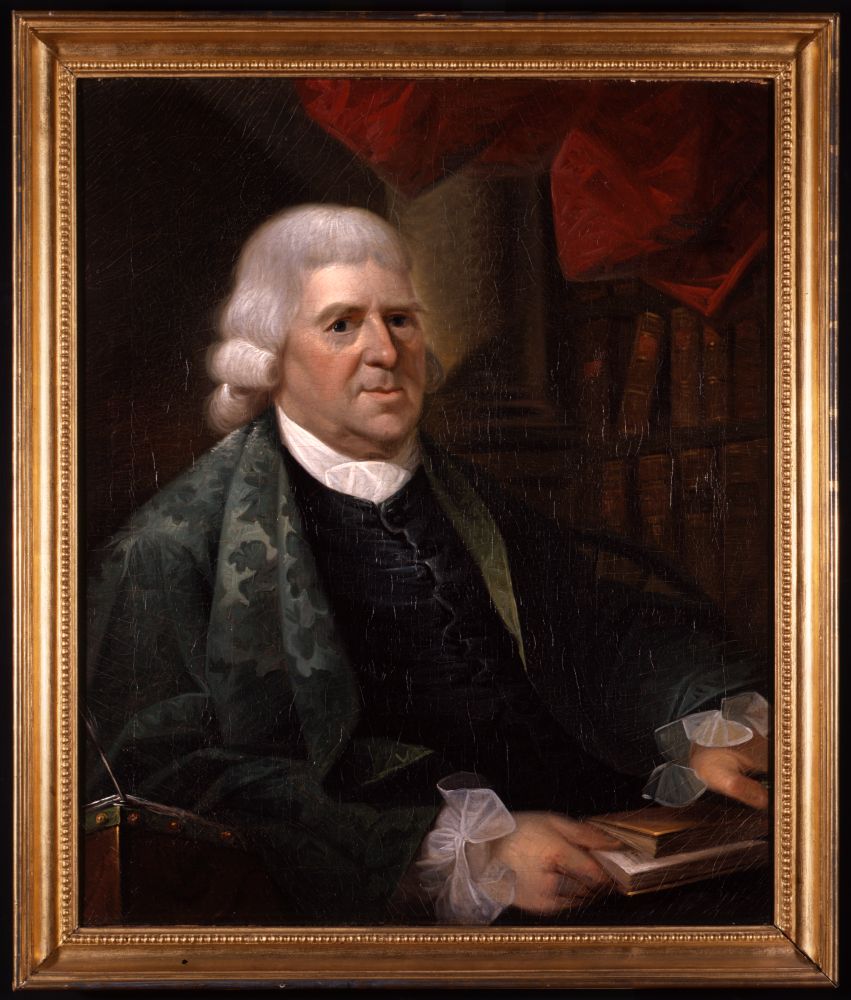
Fig. 1. John Johnston. Samuel Dexter (1726–1810). Oil on canvas, 1791. Courtesy, American Antiquarian Society, Worcester, Mass.
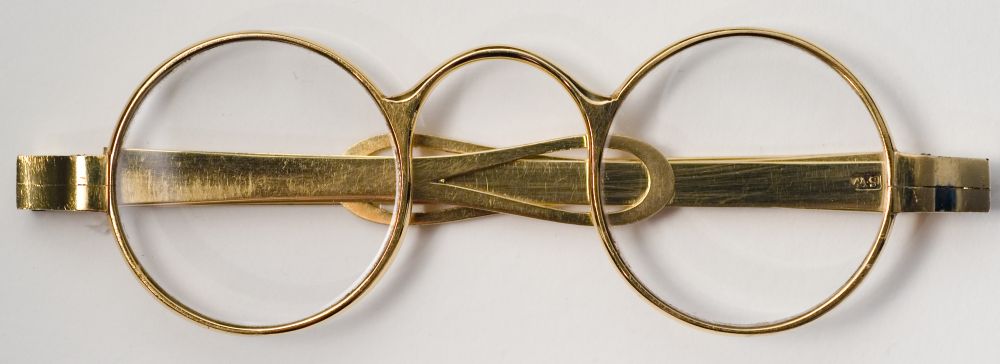
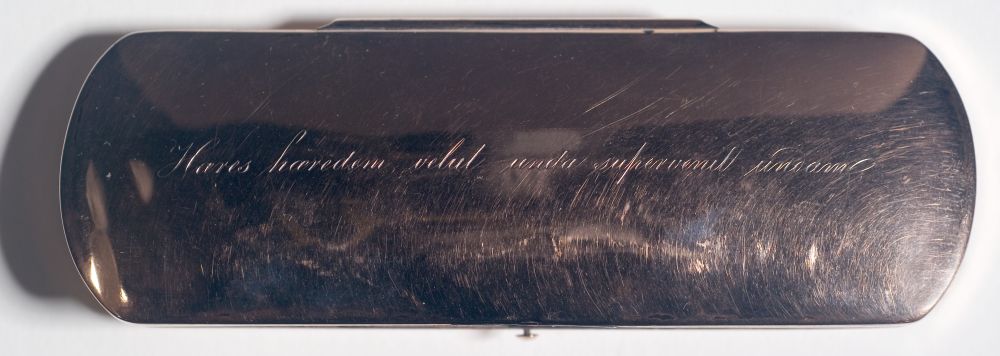
Fig. 2. Gold temple spectacles, ca. 1785, and gold-plated spectacle case, ca. 1810 belonging to the Dexter family. Courtesy of the Massachusetts Historical Society, Boston, Mass.
Look beyond surface reflections, however, and it becomes clear that the Dexter spectacles and case tell a story with a wider circuit. The spectacles do capture Samuel Dexter’s struggle in his last years to liberate himself from material expressions of pride or avarice; all the while he remained dependent upon a device that both enabled the virtuous habits he wished to cultivate while it simultaneously expressed the vices he hoped to weed out. But, as it turns out, Dexter’s son Samuel is the one who bought and inscribed the case for the spectacles that he inherited, and who in his last years seemed to turn his back on the excesses of his youth in order to follow the general outline of his father’s lights. Hares Haeredum, Horace wrote. “Heir follows heir.” Heritage. Legacy. These are all problems of visible remains. For two generations, then, these spectacles corrected vision, negotiated print cultures, and testified to early Americans’ conflicted attempts to style themselves as serious, rational readers. This larger tension between the virtue of learning and the vice of fashion resonated in the particular circumstances of the Dexter men, for whom the spectacles came to serve as a memorial to a multigenerational struggle to balance religious faith against secular success.
* * *
Born in 1726, the elder Samuel Dexter had a long career as a reader (and writer), and one that tells a familiar story of a Republic of Letters built on the Puritan faith in literacy and an expanding commercial reliance on numeracy in the Anglo-Atlantic world. After being trained up to follow in his father Samuel’s footsteps through Harvard and into the ministry, Dexter had shocked his parents by proving perhaps too much inclined toward scholarship—on the strength of his own reason and reading, and fueled by a contrary nature, he soon questioned Christianity’s claims to divine authority, abandoned Calvinism as a doctrine that “did violence to the moral attributes of God,” and departed Harvard to apprentice himself to the Boston merchant Samuel Barrett.7 Within fifteen years he had married, started his own shop, fathered five children (of which four lived), and made so much money selling Britain’s baubles to his fellow colonists that, a year later, he retired.8 In 1762, flush with pride in his speedy success, Samuel Dexter left his mercantile business for a position in the Massachusetts legislature, only to find himself openly at odds with the other patriots on how to conduct the Revolution. In a dramatic move, and perhaps one driven by his descent into an especially dark period, Dexter chose to extract himself from his commercial and political networks, removing to the relative wilds of Woodstock, Connecticut.9 Restored to health by strict dedication to none but “his family and a very few friends,”10 “the management of . . . private concerns,”11 and his extensive library, which was remembered as “the wonder of all the villagers,” he eventually came to embrace and enjoy the area, which made him feel “as if we were out of the world.”12
Once smallpox drove the Dexter family from Woodstock at the close of the Revolution and his wife died of cancer, Samuel lived a less settled life, and one focused on earnest preparations for his own demise.13 In the spring of 1785, he sold his family’s Dedham property, then moved to Marlboro, then Roxbury, then Weston, and, finally, he spent the last decade of his life in Mendon, Massachusetts.14 All the while he grew ever more engrossed in the “large and choice library” that he had insisted on carting with him to each new place. It “attracted much attention at the time of its removal,” one writer recalled, “but he was greatly devoted to the use of it in his retirement.”15 Sometime between leaving Woodstock and arriving at Mendon, Dexter came by his golden spectacles, either in response to the normal aging of his eyes, or possibly after hitting his head above the eye in an accident in January of 1788 as he was preparing to depart for church. All those books, and all those miles. Imagine for a moment what it would be like to be Samuel Dexter as he watched those letters gradually blur before his eyes.16 Although he lived in a kind of self-exile after 1775, he never left the universe of ideas preserved on the page, and, in the end, that was the home he most cared about. To be expelled from the pantheon of patriots was one thing, to be banished from books quite another. To maintain his independence as a reader, and to unlock the door to his domain, Dexter had to have those spectacles.17
In theory, Samuel Dexter could have had spectacles made by someone connected to his brother, John, a Marlboro goldsmith.18 But it is unlikely given that Americans did not seriously attempt to copy and improve upon the English style of spectacles until the fledgling optical industry opened up shop in Philadelphia around the turn of the century.19 Another possible source could have been someone like his brother Ebenezer, a physician, for on a handful of occasions physicians dispensed spectacles in the colonies during the eighteenth century.20 But Ebenezer had died before the war, and, in any case, Samuel’s generation did not usually look to the emergent medical community for this kind of cure. Instead, people sought spectacles on the advice of family, friends, and even acquaintances; purchased pamphlets like those written by the English spectacle makers James Ayscough, Benjamin Martin, and George Adams; or—as in Dexter’s specific case—consulted popular reference works like William Buchan’s Domestic Medicine.21
Primed by earlier reading in Buchan, Dexter would have done his best to select appropriate lenses from the range of powers stocked by a merchant. He probably procured the spectacles through a watchmaker like J. Deverell, who advertised “an elegant pair of Gold Temple Spectacles” for sale in Boston in 1785, or a merchant like Amos Atwell, who had opened a shop in 1791 that sold “Fresh Goods,” including spectacles, directly across from Samuel’s oldest son Andrew’s store in Providence, Rhode Island.22 Merchants like these had been importing spectacles, mainly from London, on a regular basis going back to the 1710s. Starting in the 1720s, the Boston bookseller Daniel Henchman’s account and day books suggest that the sale of spectacles started to take off. Between 1713 and 1748, his sales climbed from twenty to 981 pairs, while the population of Boston doubled (fig. 3). All the while he sold more spectacles to traders from outlying towns.23 After the French and Indian War, advertisements show a growing variety of styles of spectacles available from an increasing number of outlets on the coast, and even beyond the coast, in smaller towns throughout many of the colonies, especially in the north and mid-Atlantic (fig. 4). These spectacles went home, alone or in sets of half or one dozen, in the pockets of the elites, artisans, many of middling status, and their mothers, fathers, friends, nurses, and maids.24
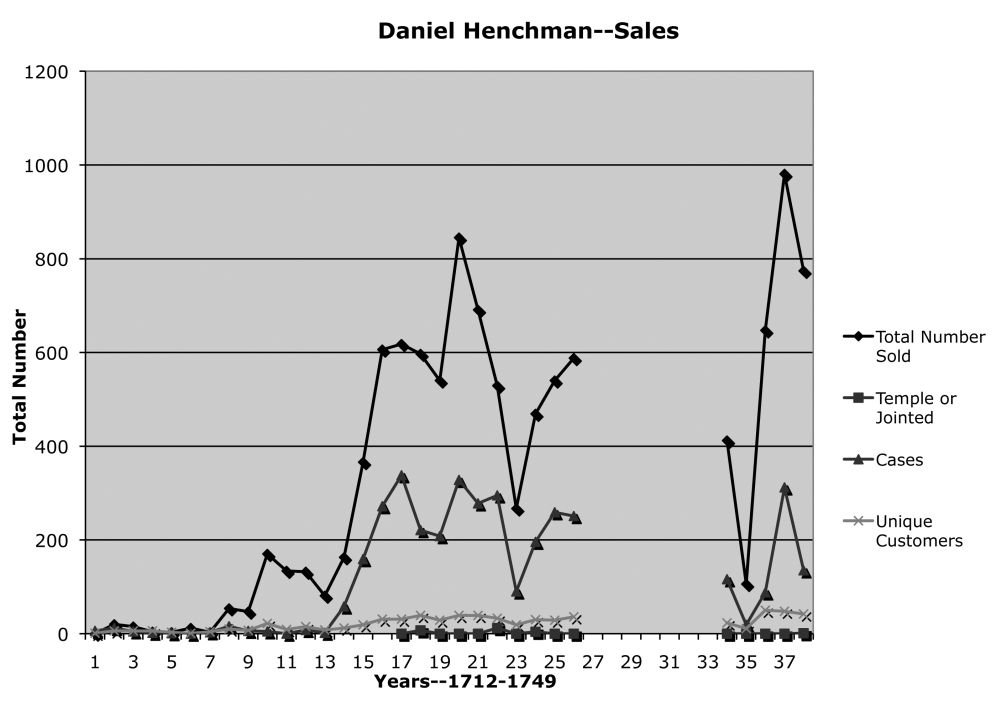
Fig. 3. Chart showing sales of spectacles and number of customers buying spectacles in Daniel Henchman’s Boston bookshop, 1712–1749. Based on the Daniel Henchman account and day books. Microfilm at the American Antiquarian Society.
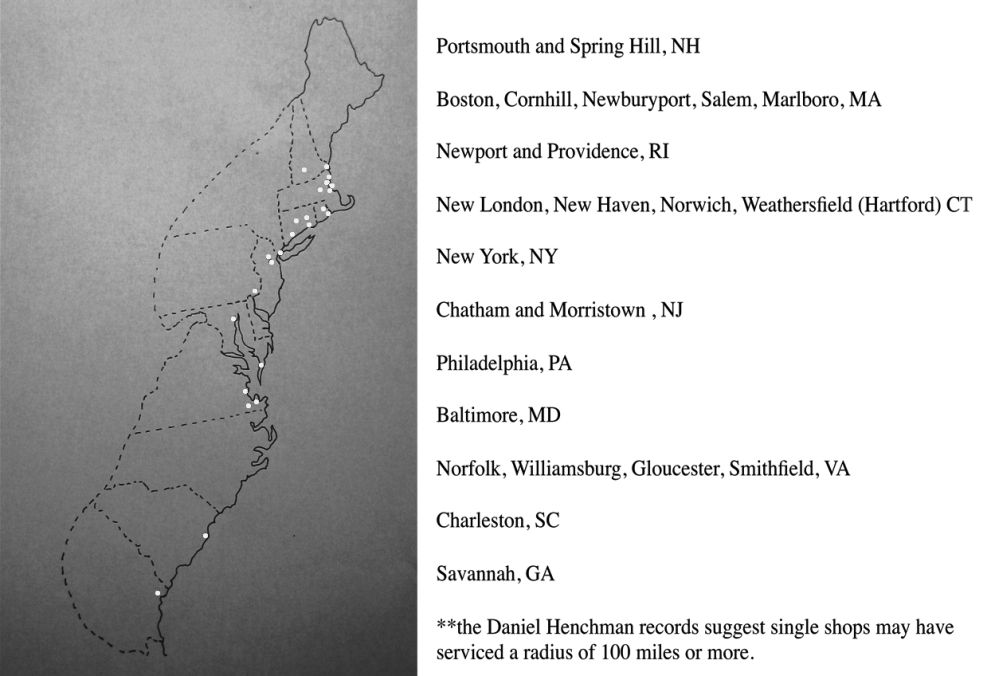
Fig. 4. Map showing cities and towns with one or more shops selling spectacles from the 1760s to the 1780s. From top to bottom, the cities and towns are: Portsmouth and Spring Hill, N.H.; Boston, Newburyport, Salem, Marlboro, Mass.; Newport and Providence, R.I.; New London, New Haven, Norwich, Wethersfield, Conn.; New York, N.Y.; Chatham and Morristown, N.J.; Philadelphia, Penn.; Baltimore, Md.; Norfolk, Williamsburg, Gloucester, Smithfield, Va.; Charleston, S.C.; and Savannah, Ga. The Daniel Henchman records suggest single shops may have served customers within a radius of 100 miles or more. Based on advertisements collected in three electronic sources—Digital Evans, Past Portal (Colonial Williamsburg), and the digital edition of the Pennsylvania Gazette—and checked against the Prime file at Winterthur Museum, Winterthur, Del. Map by author.
Owners, like the spectacles themselves, varied, but they nearly all shared at least one thing: old age. Advertisers offered correction for short sight as well as long, but the vast majority of buyers bought convex spectacles for correcting the defects that develop as the eye ages, a trend also suggested by the near total absence of concave spectacles from the period in extant collections.25 For most of Dexter’s lifetime, buying spectacles meant taking up what are referred to today as reading glasses, and few in that day missed the connotations of physical and mental decline that came with their use. Stories celebrating those who managed to live into the eighth decade or beyond without the need for spectacles perennially registered a resigned attitude toward spectacles, and the continual wish that perhaps another cure for aged eyes might someday be discovered.26 Glimpses of one’s bespectacled face in a mirror surely whispered: remember death.
Not that Samuel Dexter needed reminding. By the time he got his spectacles, Dexter’s focus had already shifted from earthly matters to spiritual questions. Thanks to his spectacles, Samuel penned letters and his mother’s obituary, but mainly he spent his time writing for himself: he produced unknown quantities of manuscript pages, which he periodically burned in fits of shame; a thirty-seven-page will with two lengthy postscripts and two even lengthier codicils; his three-hundred-and-thirty-page-plus commonplace book, which he took time, before dying, to edit with pen as well as penknife; and one surviving palimpsest probing the validity of Trinitarian versus Unitarian doctrines. All betrayed his renewed interest in living a Christian life, and all put his spectacles to the kind of use they were designed to encourage: hands-on reading of many texts in succession, lengthened hours of writing and revising, more time spent attending to every detail on the page.27
The single piece Samuel Dexter produced for broad public consumption during his bespectacled period was a sixty-page anonymous pamphlet in which Dexter used a close reading of the marginal translations included in the King James Bible to argue God did not damn Esau for failing to be a “second-sighted man.”28 This argument also conveniently absolved Dexter of what he came to consider the cardinal sin of his life: his rejection of the opportunity to continue his father’s ministry in favor of the pursuit of worldly wealth and status. To atone for the folly of his youth, Dexter made plans for a funeral sermon that, by his own strict instruction, would make no mention of him—the deceased—at all. Instead, it would be a meditation on a passage from Paul’s second letter to the Corinthians, chapter four, verse eighteen: “The things which are seen are temporal; but the things which are not seen are eternal.”29 Decrying the ambition of those who sought to “lay up treasures on earth” and in “their vicious lives appear to be totally regardless of the doctrine of future existence”—in other words, condemning his younger self—Dexter urged the minister to tell “his hearers to imagine they hear ONE FROM THE INVISIBLE WORLD asserting this great truth, that ‘things which are eternal,’ are infinitely more important than ‘things which are temporal.’”30
Only Dexter was not, as he imagined himself to be, growing more virtuously immune to the lure of earth’s treasures in his waning years. The Dexter that claimed to care nothing for the visible, material world is the same Dexter who simultaneously eschewed the many more modest choices of spectacles available in favor of the most expensive, most up-to-date, most formidable and flashy spectacles that could be had. Costing as much as four times what the same design would fetch in silver, and ten times as much as the steel version.31 Dexter’s spectacles were in the newer style, called temple spectacles. Developed in the mid-eighteenth century by the Worshipful Company of Spectacle Makers, temple spectacles eventually replaced the considerably more fragile and inconvenient armless designs made of horn, fishbone, wood, or thin strands of metal that had circulated for four hundred years (figs. 5 and 6)32 The London spectacle guild had parlayed its late seventeenth-century connections with members of the Royal Society and its eighteenth-century connections to the crown into dominance of the vision aid market, both at home and in the American colonies.33 The company capitalized on immigrant labor from Italy and the fortune in raw materials, including gold and silver extracted in distant realms by slave or indigenous labor, which increasingly flowed through Atlantic trade networks and into English hands.34 The spectacle makers advertised their wares as part of a spectrum of fashionable aids intended to enhance scientific inquiry and promote aesthetic development (figs. 7 and 8)35 In the colonies, the emergence of temple spectacles coincided with a shift in where spectacles were commonly sold, from being offered in bookstores, post offices, and print shops to being offered as one more item in the general avalanche of English goods from any number of merchants.36 During periods of non-importation, some Americans branded spectacles necessities by labeling them cutlery, and long after the Revolution many sellers categorized them as hardware, as Amos Atwell did.37 Yet, no matter what Revolutionary-era Americans like Samuel Dexter told themselves, when they purchased these types of spectacles, they bought into a vast commercial and imperial network heavily dependent upon vision to perpetuate and secure its hierarchies.
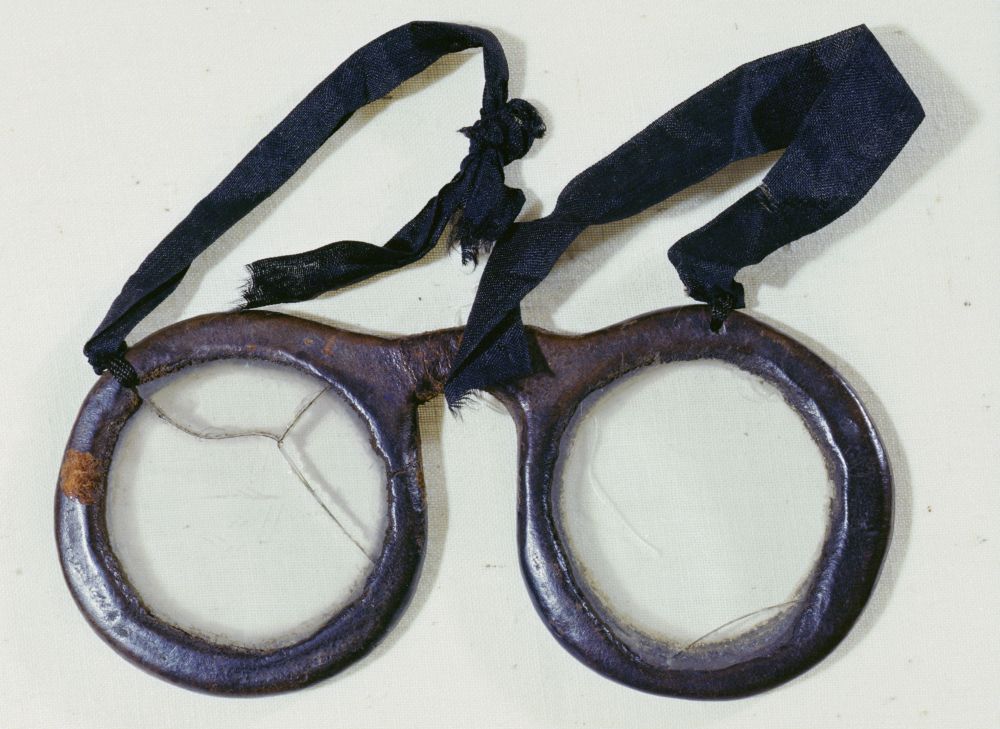
Fig. 5. Unknown. Leather spectacles attributed to Esak Hopkins. United States, ca. 1770. RHi X4 276. Iron, glass, leather, and silk ribbon. Personal Gear. Museum Collection. 1921.1.47. Courtesy, the Rhode Island Historical Society.
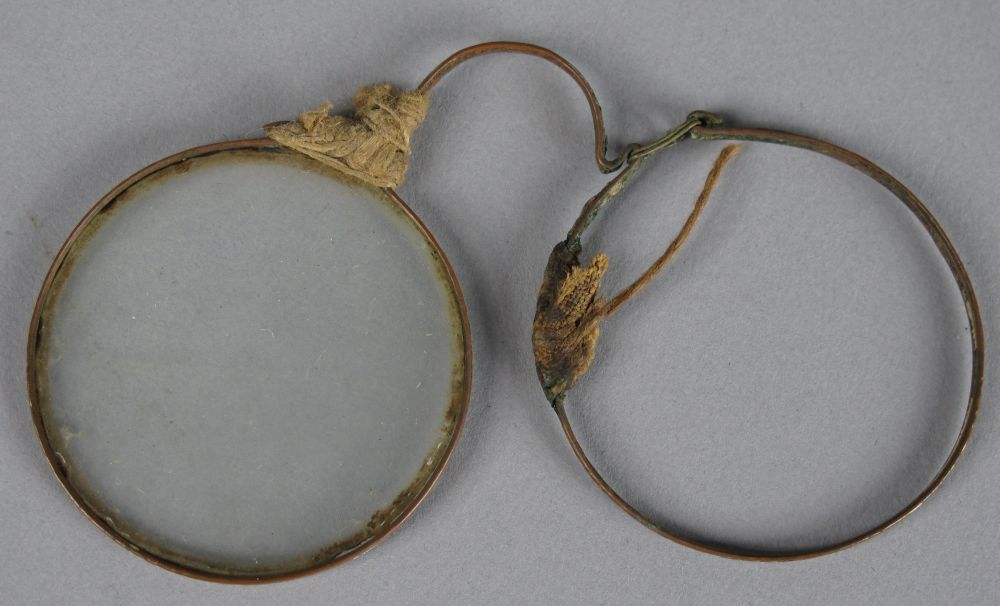
Fig. 6. Wire-rimmed spectacles, owner unknown, 18th century. Gift of Mrs. Carl W. Noren, Connecticut Historical Society Collections. Courtesy, the Connecticut Historical Society, Hartford, Conn.
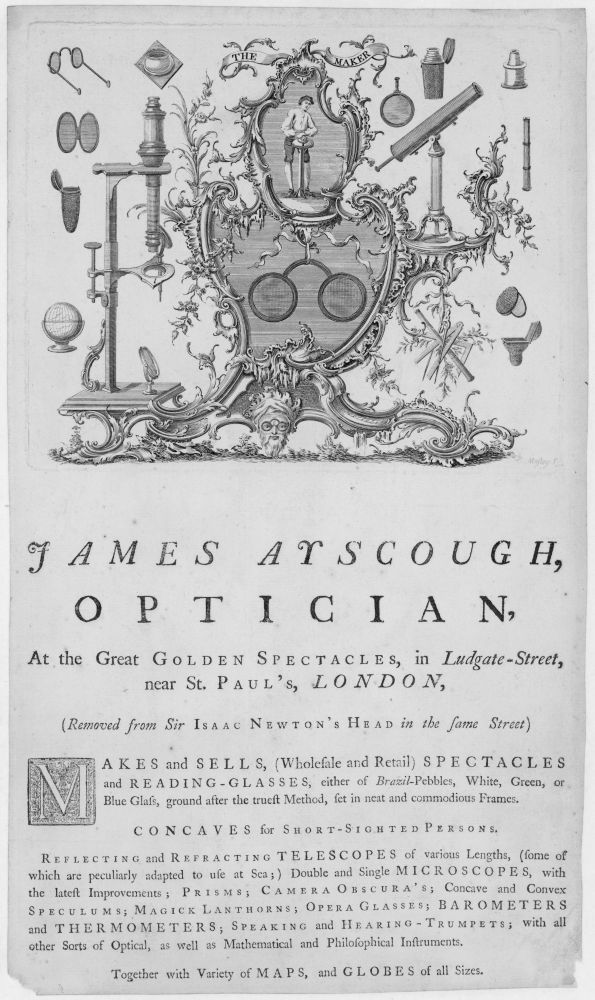
Fig. 7. Edward Scarlett Trade Card (mid-eighteenth century). Courtesy of the Science & Society Picture Library, a division of the National Museum of Science and Industry, London, England.
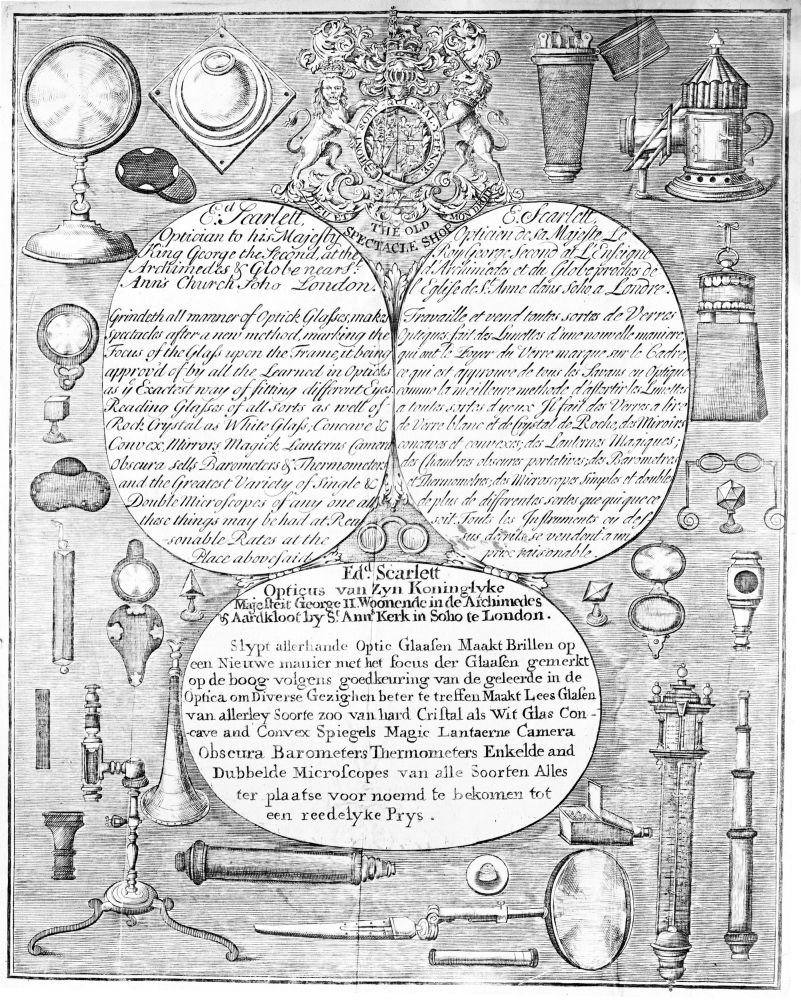
Fig. 8. James Ayscough Trade Card (ca. 1750). Courtesy of the Science & Society Picture Library, a division of the National Museum of Science and Industry, London, England.
In refashioning spectacles at mid-century to be more reliable and refined, the Worshipful Company had also made them, in a way, less polite. Temple spectacles might be durable and practical, but they were much less discreet than the designs that had preceded them. This may well have been part of the reasoning—another part being the bald admission of age and decay—behind why Samuel Dexter decided not to include them in his portrait.38 As props, books were well established as sending a positive message of improvement to the viewer, but until the second quarter of the nineteenth century, Americans declined to allow the spectacles the same status.39 Although spectacles always represented an investment in the word—and in Samuel Dexter’s case, a significant investment—they remained too forceful a reminder of the lure of the material world and the discomfiting power of the gaze. As beautiful as the spectacles were, they showcased the level to which refinement depended on calculated display.40 The older Samuel Dexter got, the more distressed he became by his own visibility, and the more completely he sought to escape or repress it. In the same year that he sat for his portrait, for example, Dexter decried at length his decision to mark the height of his success in the 1760s by commissioning a fake coat of arms for his family. As an old man, he “concealed [the herald] . . . in a trunk, in my closet, and, probably, its end will be to be burned,” along with a handful of “literary vanities. . . . I despise it,” Dexter went on in his commonplace book, “and myself for having procured it.”41 No surprise, then, that even though he depicted himself as a reader, Dexter would decline to capture his unusually expensive temple spectacles in his portrait. Gold temple spectacles signaled exactly the kind of fashionable inflation of self-importance that Dexter wanted to consign to his past.
As much as he may have wished it, in truth Samuel Dexter’s funeral message did not come in the form of an immaterial voice from beyond. It, too, had a material manifestation—six hundred copies prepaid by Dexter and issued from the press of John Eliot “on good paper, with a fair type,” just as Dexter himself had directed. The spectacles and the sermon, and many of his final preparations, betrayed the fact that as Dexter tried to make choices informed by his deepening spiritual convictions, he nonetheless grew increasingly concerned about how he looked to posterity. Witness not only the burned manuscripts and the heavily edited commonplace book, but also his final request for “a plain coffin of pine board, blacked, without a cloth covering, and without any kind of inscription, or other ornament.” In his will he forbade “any gentlemen, termed persons of distinction and figure, to be my pall-holders,” thereby excluding many of his friends. Instead he preferred to purchase the services of “twelve men of sober life, who have families in poor circumstances, of or near the town, or parish to which I last belonged” for the sum of “five dollars and a pamphlet.” Similarly, he requested that “any poor persons” who had watched over him be paid “thirty-seven cents and five mills” for each night at his bedside. Setting aside rings as parting gifts for friends, he worried aloud that they would be considered an old-fashioned gesture. “As I have not of late years mixed with the fashionable world, I know not but some other memorial of friendship, respect, or affect has been substituted in the place of rings,” he wrote. “My executors are to conform to custom in this respect.” Without question, the generous will continued to dispense his remaining fortune as Dexter had done, or was suspected of having done, in life, with over five thousand dollars famously set aside to fund the study of scriptures at Harvard. Yet even as he cautioned his relatives against “showy and ostentatious” expressions of mourning, believing “great evil grows of the practice,” Dexter admitted that it was possible to go so far in the other direction that one risked being “censurable for [one’s] singularity.”42 In other words, it was beginning to dawn on Samuel Dexter that in his rush to encourage righteous simplicity, he might be promoting something like conspicuous non-consumption.
Samuel Dexter’s spectacles, and his faith, helped him read and write to a ripe old age. In January of 1802, he complained of “ophthalmia”—a term applied to many eye ailments in that day—and feared “total blindness.” On his eighty-third birthday in March of 1809, he penned again his yearly expression of “holy gratitude . . . for any mitigation of my bodily pains & infirmities” that God saw fit to bestow.43 At the time of his death the following summer, Dexter’s spectacles passed to his youngest son and namesake, Samuel, presumably in the unlisted jumble of personal effects and household goods divided by his sons and sons-in-law according to the instructions left in the otherwise voluminous will, some of which was reproduced against his wishes along with his funeral sermon.44 Sometime in the handful of years between Samuel the father’s departure from the earthly realm in 1810 and Samuel the son’s abrupt death during a scarlet fever epidemic in 1816, Samuel the son had the gold-plated case made.45 The youngest of Dexter’s children, born in 1761 at the height of his father’s mercantile career, Samuel had decamped to Woodstock with his parents in 1775 only to return to Cambridge in the fall of 1777 to enter Harvard. He finished at the top of his class, went on to study and practice law, dabbled in banking, and served as Secretary of War in his close friend John Adams’s administration, as well as briefly as Thomas Jefferson’s Secretary of the Treasury.46
That the elder Samuel carried his prize spectacles about without a case could not have been numbered among his unusual habits. According to the Henchman accounts, purchasers usually bought spectacles without cases.47 By 1810, however, there was an emerging sense that every pair of spectacles deserved its own protective container (figs. 9 and 10). In addition, both and either could be marked with not only makers’ marks and buyers’ or sellers’ addresses, but also personal names or initials and a rudimentary system for denoting powers of vision.48 While spectacles began the eighteenth century as an unreliable tool for reading, spectacles in the first quarter of the nineteenth century demanded more directly than ever to be read, literally and figuratively, as an increasingly substantial public declaration of private property, individual bodily ability, and basic belief in the value of literacy and numeracy.
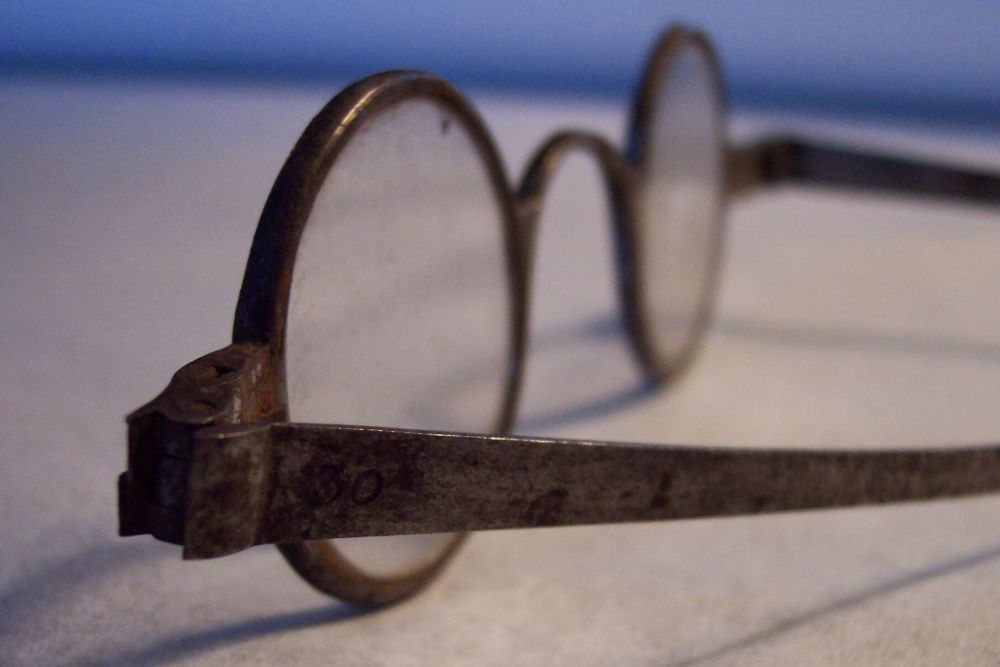
Fig. 9. Temple spectacles (ca. 1800). Marked with a “30” (to denote the power of the lens, probably by reference to age) on the outer left temple piece. Photograph by the author. Courtesy, Rokeby Museum, Ferrisburgh, Vt.
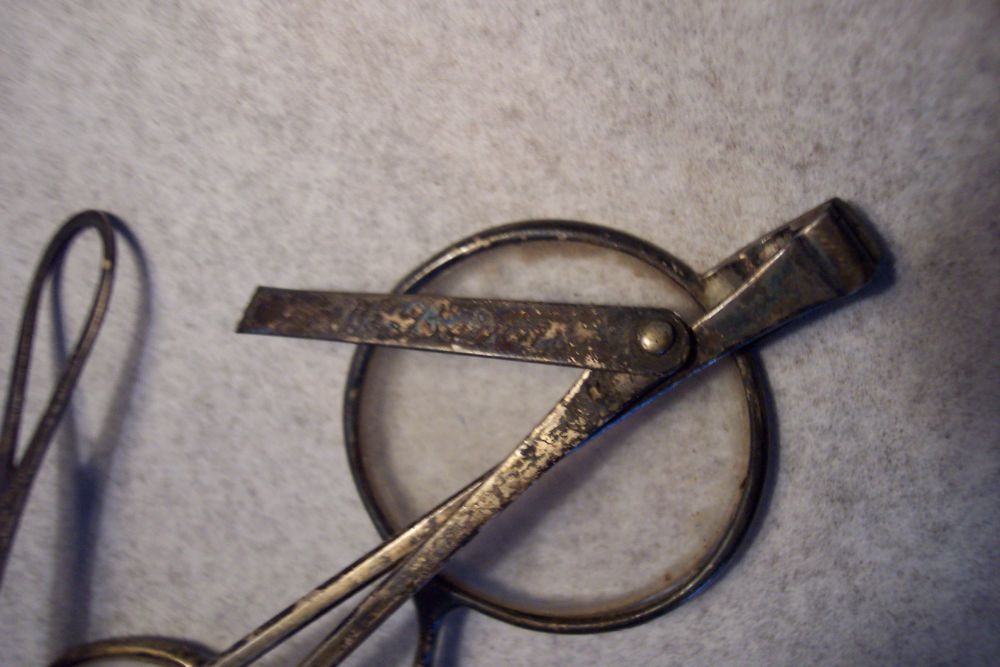
Fig. 10. Temple spectacles (ca. 1810). Photograph by the author. Courtesy, Rokeby Museum, Ferrisburgh, Vt.
For Samuel the younger, the case presented an unusual literary opportunity (fig. 11). On it and through it he renewed and revised the themes of visibility and invisibility, heritage and legacy that so consistently absorbed his father’s attention. Like the obituary that appeared in magazines and newspapers during the summer of 1810, which Samuel the son is suspected to have authored, the engraved case provided a comment upon his father’s generosity and personal style.49 More than that: it functioned as a piece of revisionist history, not unlike his father’s faux coat of arms. For example, though Samuel Sr. was certainly familiar with the works of Horace, he did not record owning any editions of Horace in his library inventory, nor did he comment at length upon Horace in the pages that remain in his commonplace book. He did, coincidentally, make a bare mention of Horace when he had injured his head above his eye back in 1788, but whether his son had any idea of this is extremely hard to say.50 Son Samuel emulated and enjoyed Horace more extensively, at Harvard and through his correspondence with his friend John Adams, who owned and quoted freely from several editions.51 And while the father Samuel almost certainly used his spectacles to peruse his multivolume set of The Spectator, like many, many others did in the eighteenth century—one does not have to look far to find spectacle buyers leaving Daniel Henchman’s bookstore with copies of The Spectator in tow52—in fact Samuel Sr. never sat, as it might seem, gazing at his case, with words extracted from The Spectator branded across the reflection of his bespectacled face.
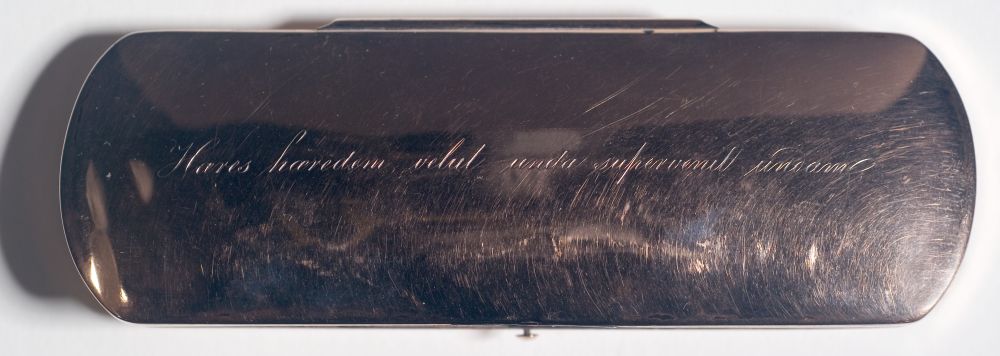
Fig. 11. Gold-plated spectacle case belonging to the Dexter family, ca. 1810. Courtesy of the Massachusetts Historical Society.
Son Samuel read both Horace and The Spectator, and responded by linking them, through the case, with his father’s life and the glasses left in his care. This was not an obvious connection to make, in part because Mr. Spectator and the denizens of the coffeehouses did not conspicuously or uniformly mark themselves by wearing actual spectacles. Isaac Bickerstaff, the lead persona in Steele’s Tatler wore old-style nose spectacles.53 But in The Spectator, though Mr. Spectator boasted “I have, methinks, a more than ordinary Penetration in Seeing,” Addison and Steele chose to forgo depicting actual spectacles in favor of portraying the act of social observation as akin to the sense of wearing spectacles. In some later engravings of coffeehouses, temple spectacles functioned as a conduit for information, a frame for scenes, and as a mask that created the kind of urban anonymity upon which Mr. Spectator thrived.54 And in both serials, they repeated one conceit, that in public spaces people made snap judgments based on nothing but “the Intimations Men gather from our Aspect,” because “A Man, they say, wears the Picture of his Mind in his Countenance.” Moreover, Mr. Spectator went on, “one Man’s Eyes are Spectacles to [those] who look at him to read his Heart.”55
This posture had social dimensions, but for Samuel the son, it had very personal dimensions as well. It mimicked the stance that his father took in relation to him as he set out for Harvard. From the start, his father’s advice had a clear theme: literacy, and the growing role it played in making a living. Samuel the son’s studies would not be for the sake of pure intellectual or spiritual development, they would have to prepare him to support himself. In a way, his father argued in a letter, this education was his inheritance, invested.56 At Harvard, son Samuel mounted a mini-rebellion just as his father once had, immersing himself in epic poetry and publishing a long poem extolling “The Progress of Science.”57 He quickly found himself more inclined to read things from a secular perspective, and without the guilty conscience that plagued his father. He also wasted no time in fretting over the volatility of the new economy, as his father once had. Instead, he tried to make circumstances work to his advantage, and as the fortunes of his sometimes quite public speculative enterprises abruptly rose and fell in the early Republic, Dexter moved quickly on to the next big thing with scarcely a backward glance.58
The spectacle case suggests Samuel did not miss some of the ironies in how he ended up using his inheritance, such as it was. In his letter, Horace reminded his friend Florus, “Experience shows you, as your riches swell / Your wants increase. . . . With heirs following heirs like waves at sea, / And no such thing as perpetuity,” Horace asked, “What good are farmsteads, granaries, pasture-grounds / That stretch long leagues beyond Calabria’s bounds, / If Death, unbribed by riches, mows down all / With his unsparing sickle, great and small?” Instead of obsessing about accumulating a fine estate to pass on to his descendents, Horace vowed in the letter that he would not “fear what my next heir may think” if the descendent found “There’s less than he expected left behind.”59 As Michael Ketcham has argued, various essays in The Spectator also addressed this issue, tracing the dissolution of traditional forms of society, which were often figured in inheritance. But rather than bemoaning the sad state of affairs, The Spectator’s writers set to replacing the old modes of exchange with new stories that reconciled people to the social and economic flux around them, while demonstrating, as Erin Mackie has pointed out, how to remain upstanding consumers on such unsteady terrain.60
That meant that for Joseph Addison, Horace’s dark view of material acquisition provided the impetus to ponder the deepest questions of existence. As Mr. Spectator wandered the fields and forests of his friend Sir Roger Coverley’s estate, he looked beyond the land to think about Horace’s view of heredity in an entirely different way. Why, he wondered, did “the Soul, which is capable of such immense Perfections, and of receiving new Improvements to all Eternity, . . . fall away into nothing almost as soon as it is created”? Turning to the extract, Mr. Spectator concluded that, since “Man can never have taken his full measure . . . before he is hurried off the Stage, . . . he does not seem born to enjoy Life, but to deliver it down to others.” Thus, he argued, men should look “on this World as only a Nursery for the next,” in which, he reasoned, “. . . The several Generations of rational Creatures, which rise up and disappear in such quick Successions, are only to receive their first Rudiments of Existence. . . Afterwards,” he concluded, souls are “to be transplanted into a more friendly Climate, where they may spread and flourish to all Eternity.”61
Dexter’s spectacle case offered a tangible way to experience the lesson encapsulated in this quote. The Dexter spectacles were made of solid gold, instead of the more common silver or steel bows, which meant that they wouldn’t tarnish or rust. Their brilliance lasts for what, to humans, seems like forever.62 How could such a precious and lasting thing have persuaded Samuel Dexter to put aside earthly riches? It could if Dexter looked through those spectacles, not at them. If he looked through them to read the gold-plated case in his hand or on his desk, he would be materially reminded of Addison’s vision of the earth as heaven’s hothouse, or Horace’s vision of the deeply illusory quality of material possessions—the lesson that, as Shakespeare famously put it, “All that glisters is not gold.”63 If looking through the gold spectacles to view the plated case did not remind Dexter the younger to focus his vision, as his father had come to, on lasting, invisible, heavenly goals, then at the very minimum, it suggested to him that he was capable of learning to sense when he was in the presence of things of real value versus things bearing only a surface shine. But to make the material motto work, Dexter would have to keep reading the text—and not let his eyes refocus on his own image, that of the smartly ornamented spectator reflected in the case.
In this way, Dexter molded his father’s meditations concerning the invisible, spiritual world into a very visible secular object lesson. And perhaps by 1810 he believed he had begun to learn it—after all, Dexter had the case made right around the time he took his final major office, that of the first president of the Massachusetts State Temperance Society. In a similar maneuver, three weeks before his illness and subsequent death, he happened to produce a manuscript titled “Thoughts on the Immortality of the Soul.” In it, the younger Dexter argued for the existence of the invisible world on the basis that scientists had shown that “the inability of a blind man to discover colors . . . does not disprove their existence.” This prompted one eulogist to applaud his “far reaching and comprehensive view, beyond the ken of ordinary optics,” just as the “gigantic telescopes of Herschell and Rosse . . . surpass all others, in their powers of celestial investigation.”64 For Samuel the son and his contemporaries, temple spectacles belonged more firmly to the realm of science, the logic of which could be substituted for traditional religious reflections.
At least once the case and its message attracted attention. Years after Samuel the son’s death in 1816, one of his contemporaries recalled it, writing that “Mr. Dexter . . . had great pleasure, in treasuring up the memorials of those, who were the natural guardians of his earlier years. I recollect, that he had preserved a pair of spectacles, which had belonged to his father, and for which he had caused a case to be prepared, bearing for its inscription—Hares Haeredem velut unda supervenit undam.” By then, however, the context had shifted again. Instead of pondering the quote’s original sources, the Epistles or The Spectator, the words reminded him, he wrote, of a letter of Daniel Webster’s, in which Webster “expressed much anxiety to find a pair of steel spectacles, which his father had worn, the last ten years of his life; he feared they were lost, but [after] devot[ing] a day to hunting for them, he found them.” The lesson, Dexter’s friend wrote, was that it was not “an unusual thing, for great men to enjoy a peculiar satisfaction, in looking through the eyes of their fathers.”65 As much as those who inherited the revolution talked about seeing through their father’s eyes, though, descriptions suggest that the younger Samuel Dexter did not use the spectacles all that much before he died at the age of fifty-five.66
Thus, in matters of spectatorship, the Dexter spectacles and case did not function as simple lens and mirror. They mark the intersection of broader trends in the dissemination and use of spectacles with one family’s own shifting understanding of salvation and birthright. They are fine specimens of eighteenth- and nineteenth-century vision aids, and they capture the contradictions and complications that marked the understanding of the visual world at that moment in history. But gaze on them from another viewpoint, and their shapes quickly shift into something altogether different.
Throughout the eighteenth century, users thought and spoke of spectacles as a second pair of eyes.67 For late eighteenth-century users, the new style of temple spectacles also acted as something of a shroud. Those wishing to convey intimacy or sincerity frequently felt compelled to draw back the curtain, as it were, by taking off or at least propping up their spectacles to reveal the actual, undistorted eyes behind.68 This image of the confusion of body and accessory was taken up in The Spectator, as it neared the end of its run. In the Saturday, October 18, 1712 issue, Addison reproduced a letter that referenced the fifth chapter of Paul’s second letter to the Corinthians, arguing,
. . . this Veil of Flesh parts the visible and invisible World: But when we put off these Bodies, . . . new and surprising Wonders present themselves to our Views; when these material Spectacles are taken off, the Soul, with its own naked Eyes, sees what was invisible before. . . . Death opens our Eyes, enlarges our Prospect, presents us with a new and more glorious World, which we can never see while we are shut up in the Flesh.69
“And,” the writer concluded, “methinks this is enough to cure us of our Fondness for these Bodies” and “make us willing to part with this Veil, as to take the Film off of our Eyes, which hinders our Sight.”70
When Samuel Dexter Sr. died in 1810, he was only too happy to cast off the veil and join the invisible world. So much so that, in addition to the notes about bequests, gifts, inheritances, coffins, services, sermons, and mourning, he added to his will one last set of instructions, which, as it turns out, were followed to the letter.71 After burying his wife and then his mother, Samuel Sr. began to think about the family’s vault. He grew more disgusted by the thought of bones “cast about” by cemetery workers, “disturbed and thrown together to make room for other bodies. . . It is my ardent wish to meet my relations, who have been and may be laid in my tomb, in a better world,” he wrote, but “I do not think it proper to rescind the resolution I have made” to be buried instead at “the spot hereby assigned for the place of my interment,” which he had “fixed upon . . . before I left Woodstock,” the single place where he had felt least bound by earthly concerns.72 That spot was about three and a half acres that had once been part of his farm. On his burial day, just as he wished, his poor but virtuous pall-bearers lowered his simple coffin into the center of the lot, and when the service was done, they covered it over and left it completely unmarked. The family then transferred the land to the local minister so that it might be used for “mowing, pasturage, and tillage for ever.” Though late nineteenth- century historians noted the site “has not been left vacant according to his directions,” they uniformly agreed that Samuel Dexter Sr. had succeeding in erasing all evidence of his earthly remains.73 This suggests that, in the end, the younger Samuel may have meant for the spectacle case to act as nothing more than a small sepulcher, as a place to bury the spectacles, a valuable vestige of his father. In the absence of a tomb or marker, he may well have focused his grief on this portable site, turning Addison’s epigraph into his father’s epitaph.
After his own death in 1816, observers noted that the younger Samuel Dexter lived and died by another of Horace’s quotes, from Ars Poetica: “—Si vis me flere, dolendum est / Primum, ipsi tibi.” “If you wish me to weep, you must first feel grief.” He knew, they noted, how to use his allegedly “cold and repulsive” manner to draw figurative blood and literal tears in the courtroom. Observers marveled at the younger Samuel Dexter’s way with words, and they also noted young Samuel’s ability to make abstruse concepts simple and compelling.74 No surprise, then, that interred together in their final resting place, the Massachusetts Historical Society, the Dexter spectacles and case seem to present a picture-perfect narrative of spectatorship and its technologies. But cast off the first impression. Release the clasp and cast open the casket carefully prepared by the son. Draw out the eyes that sustained his father’s lights; unfold the arms that embraced his father’s mind. Place these relics side by side, and consider them from many angles. Recognize their genealogy, as well as what they have bequeathed to the present. Return the spectacles, finally, to their dark velvet bed. As Horace’s words swing into sight, watch the Dexters disappear.
